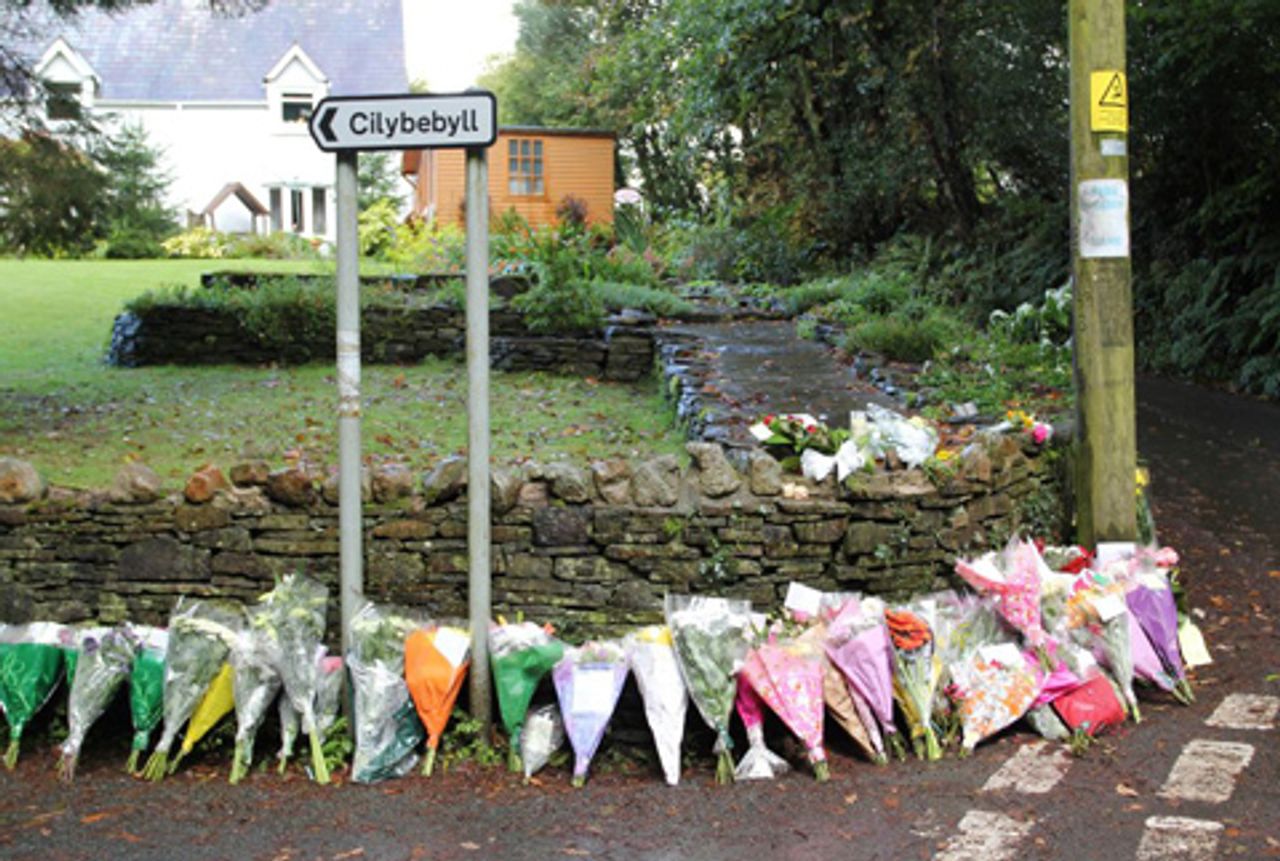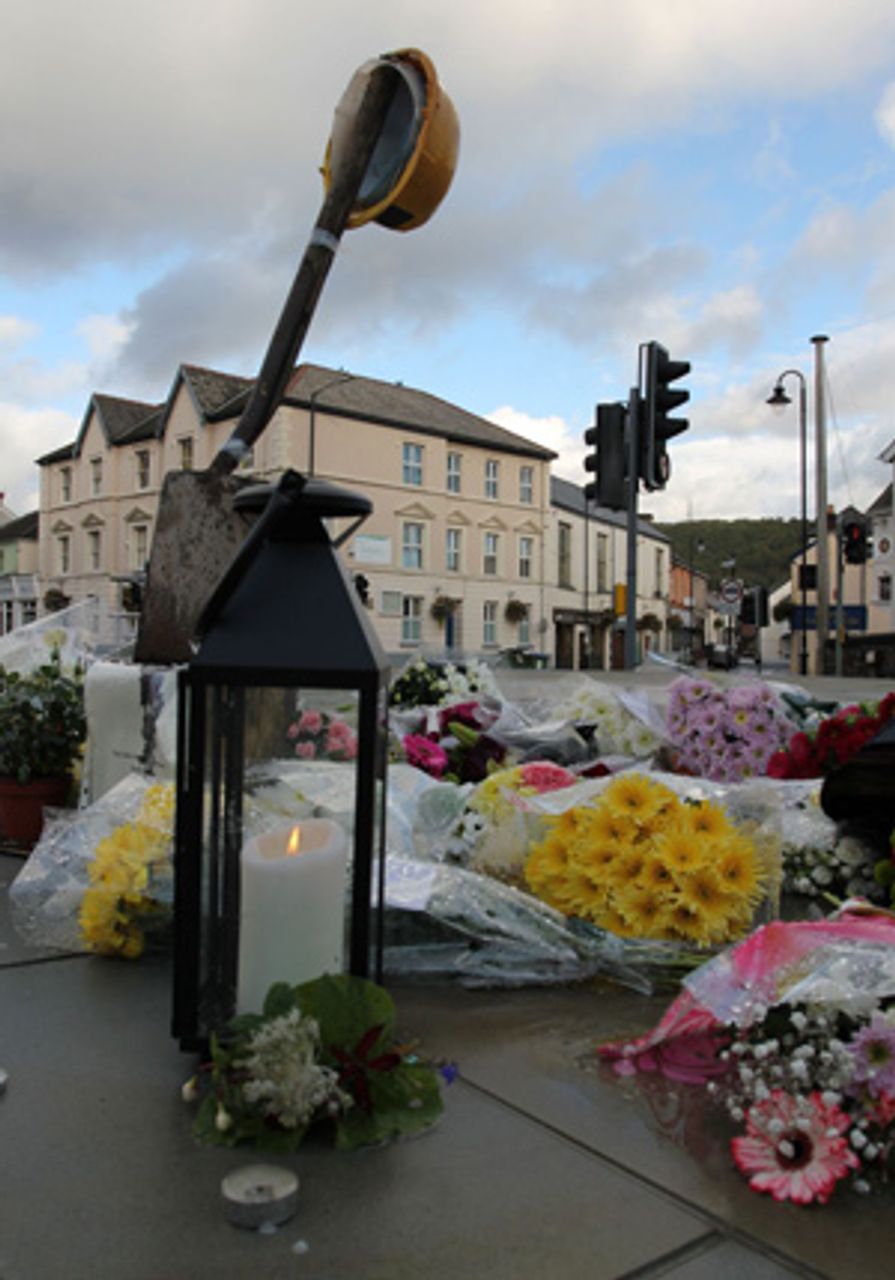 The floral tributes to the dead miners near the Gleision mine at Cilybebyll
The floral tributes to the dead miners near the Gleision mine at CilybebyllThe Health and Safety Executive (HSE) and the police have launched an investigation into the deaths of four miners at Gleision drift mine at Cilybebyll, South Wales last week.
Phillip Hill, 45, Garry Jenkins, 39, David Powell, 50 and Charles Breslin, 62, were killed when the mine was flooded, engulfing the mine’s shaft about 300 feet underground.
Three other miners managed to escape. Malcolm Fyfield, a mine manager, suffered a serious head injury while escaping and remains critically ill in hospital.
The HSE investigation, which in the initial stages is being led by the police, will not report back for months.
It is already clear from firsthand accounts that the mine was a death trap, with the probability of a disaster leading to fatalities very high.
One of the survivors was David Powell’s 26-year-old son, Daniel. He escaped along with his next-door neighbour, Mark Lloyd, and Fyfield. A family friend told the press, “All Daniel kept saying afterwards was that it isn’t safe down there. The family wants to see the pit shut for good. They don’t want anyone else to go through the nightmare they have suffered. It was a constant battle to keep the pit pumped out.”
There is also evidence that the mine, which was closed for a number of years, had been reopened by its management due to the increase in the price of coal. According to Nick Servini, the BBC Wales business correspondent, “The high quality anthracite coal mined here can be sold now for more than £200 a tonne, which has risen by around a third over the past three years.”
One former mining safety officer, engineering consultant Robert Murray-Willis, told the Wales on Sunday, “Anthracite is Welsh gold. It’s smokeless, very dense and environmentally friendly as coal goes.”
Gleision was previously owned by Coal Direct and produced an estimated 200 tons of coal a week, with a turnover of up to £500,000 a year.
The cause of the collapse of a wall and the sudden rush of water and debris that killed the miners is thought to be the explosives used to get anthracite from the seam.
Existing law covering coal companies requires that firms employ a surveyor, whose primary role should be to provide maps of nearby workings, to enable miners to work a safe distance from them. The law also legislates that mining should not be within 45 metres in any direction of a layer of rock containing water.
Miners should not extract coal in tunnels within 37 metres of any disused mine workings.
It appears that none of these regulations were adhered to at the Gleision colliery.
Did the relevant authorities in charge of safety turn a blind eye to the operations at Gleision? The HSE said the Mining Inspectorate’s records showed no enforcement notices on the Gleision colliery, which was due an inspection later this year. The Inspectorate stated that the mine passed an annual inspection on May 17, 2010.
 A makeshift tribute in remembrance of the miners
A makeshift tribute in remembrance of the miners in the town of Pontardawe
The owner of the mine, Gerald Ward, has a criminal record which includes a prosecution in 2002 for selling coal that didn’t match its description that it was anthracite, the Daily Mail reported. “Ward, who had run the mine for a year before the disaster, had not been visited once by the Coal Authority which licenses Britain’s mines.
“The local Neath Port Talbot council who own the hillside where the Gleision Colliery is located allowed him [Ward] to re-open the works even though planning permission had been given to another company.
“Owners of the Gleision pit in the Swansea Valley were recently given planning permission to start working fresh seams deeper into the hillside.”
The colliery’s coal was being mined by small scale firms, coming and going on a regular basis in search of a quick profit. Previously the Mail had reported that “a Swansea-based company called Coal Direct Ltd ran Gleision for three years from 2006 before going into liquidation with reported debts of £240,000. It applied for permission to open the underground extension but the company was then taken over by MNS Mining Ltd.
“In July last year the council approved plans to extend the mine’s workings to the east, imposing strict conditions, including the installation of additional drainage and pumps.”
According to the newspaper, “The four miners who died in a flooded Welsh colliery may have been working in an underground extension which was given planning consent last year. They are believed to have pierced an old, unknown chamber—flooded from weeks of heavy rainfall—causing tons of water to engulf them.”
Reports attest to miners working in dangerous, back-breaking primitive conditions, most closely associated with the private mining of the early 20th century. This was an era in which many miners were killed in underground disasters, before the onset of the nationally regulated safety conditions that were introduced with the nationalisation of the coal industry.
One of the fatalities, Charles Breslin, was shoveling up to 20 tons of coal a day by hand. He had worked in the mining industry since 1962. According to Wayne Thomas, the general secretary of the South Wales National Union of Mineworkers, “Charlie worked underground all his life. He was 62 but he was as strong as an ox and as brave as a lion.”
In drift mines like Gleision, miners are forced to work in intolerably cramped conditions, in which modern large coal extracting machinery cannot operate. One of the miners killed, father of four David Powell, was described as the “colliery’s maintenance engineer” in one press report. The article said that Powell “fought a never-ending battle against the pit’s serious water problems. He was often there at weekends, checking the pumps.”
A friend of critically-injured Malcolm Fyfield said of the constant problem of flooding at Gleision, “They’ve never resolved it. There are workings in there going back to the 18th Century and there’s no map for those. You have no idea how much water is building up or, if you’re extending the mine, when you might knock into it. Conditions are cramped and grim.”
A local ex-miner, Dai Thomas, told the Wales on Sunday, “There was no such thing as health and safety for these boys. It is not viable to take coal out of these small mines without cutting corners.”
Gleision is part of an associated collection of small workings, mines and pits known as the Tarenni Colliery. Privatised in 1993, in 2008 Gleision was one of just three privately-owned coal mines that remained in South Wales. Local workers were forced to work in such mines due to the collapse and running down of once massive coal and steel industries in the region.
After the nationalisation of the coal industry in 1947, tens of thousands of coal miners were employed in the coal industry in South Wales. Following the defeat of the 1984-1985 miners’ strike, all these jobs were destroyed.
One of the largest local employers previously was the Abernant Colliery, only a few miles from Gleision and opened by the National Coal Board in 1958. By the 1970s it was producing an average of 300,000 tons of coal annually, with a workforce of 900. In 1988, Abernant was closed. In 2008 the last coal mine in South Wales closed.
Communities in South Wales, such as that around the former Abernant mine, have been devastated. Unemployment has skyrocketed, with those in work often in low paid jobs. Gleision survivor Daniel Powell was earning just £9 an hour. As a neighbour told the media of Daniel’s father, David Powell, “He was a good bloke and proud when Daniel joined him down the pit. With the employment situation so bad here, his boy had no choice but to work at Gleision.”
The Sky News web site has produces a media gallery with seven images of the state of the mine as it was in 2008. The gallery can be viewed here.
Fill out the form to be contacted by someone from the WSWS in your area about getting involved.
